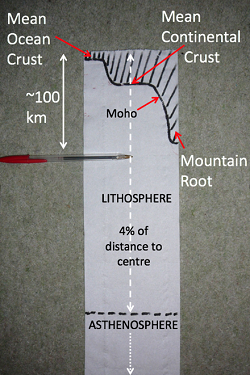Loader, P., Geology, Home-Schooling and Toilet Roll! Geoscientist 30 (5), 24-25, 2020
https://doi.org/doi: 10.1144/geosci2020-088, Download the pdf here
Peter Loader has advice and resources for those currently home-schooling
For any educator, the current lockdown provides a valuable opportunity to support teachers and parents alike in their task of home-schooling the nation’s children. This is undoubtedly providing a challenge, particularly for parents without the knowledge, experience or suitable recourses, and given the dubious quality of some of the offerings (see Letters).
Misconceptions
 Fig 1:‘What do the top and bottom of a tectonic plate look like?’ (Earth Learning Idea)
Fig 1:‘What do the top and bottom of a tectonic plate look like?’ (Earth Learning Idea)
Of particular concern is confusion resulting from the way geologists describe the chemical layering of the Earth and its mechanical structure. This has led to misconceptions, perpetrated by these websites and many geography textbooks, that can be paraphrased thus:
‘the Earth’s mantle is composed of molten, liquid rock called magma upon which the Earth’s crust ‘floats’; with the latter broken into pieces called plates, that are moved by convection currents within the mantle.’
This, despite the valiant attempts of the geological community, exam boards and the Geographical Association, to dispel such myths over many years. The ‘crustal’ part of the plate as portrayed is only the outer part of what we now know to be a ‘lithospheric’ plate; a mechanical, rather than a chemical description of the cold (<1300 oC), strong, outer Earth layer comprising both crust and the upper-most part of the upper mantle. (See Fig 1).
Similarly, the mantle can’t be molten liquid (except in very localised situations) as it transmits earthquake waves (S-waves) which are not transmitted through non-rigid materials. Whilst the detail mechanism of plate movement is still much debated, recent evidence suggests that:
• there is little or no evidence that convection currents in the mantle move plates;
• slab pull is the main plate-driving mechanism, which is part of the convection system since sinking cold, dense lithosphere itself can drive mantle convection patterns and influence mantle flow.
• ridge push can have an effect where slab pull is not the main plate driver.
Of course, this is a simplification in itself, but it is a more appropriate model with which to teach students that better reflects current understanding.
Integrity
 Left: 'Toilet roll of time’ (Earth Learning Idea) Image courtesy of Chris King
Left: 'Toilet roll of time’ (Earth Learning Idea) Image courtesy of Chris King
When I tweeted recently about errors in the BBC Bitesize provision, some asked whether this really matters, in the bigger scheme of things. To which I would argue yes, if we value the quality of our children’s education and the integrity of our subject and curricula. Not only are misconceptions something students would need to relearn further up the education ladder but it also avoids a situation where a student, studying both geography and geology at GCSE, is potentially faced with different answers to the same questions and the worry of what is going to be accepted in exams.
Some responded to my tweet by asking to be pointed towards accurate and engaging resources that could be used to support home learning, and indeed in future school lessons. I outline here just a few of the options.
Geological Society resources
A wealth of information and activities for students of all ages can be found on the Geological Society’s website (https://www.geolsoc.org.uk/education). They range from fact sheets, activities and presentations to Fun Kids radio programmes, with much else besides.
In particular, the highly acclaimed ‘Plate Tectonic’ website (https://www.geolsoc.org.uk/Plate-Tectonics) for Key Stage 3 students and upwards was written in 2012 specifically to dispel the outdated models of the Earth we see perpetuated. This was supplemented by the ‘Plate Tectonic Passport’ activities for Key Stage 2 and lower Key Stage 3 students and later by ‘Plate Tectonic stories’, in celebration of 50 years of plate tectonics.
Earth Learning Idea
 Right: Journey to the centre of the Earth – on a toilet roll (Earth Learning Idea) Image courtesy of Pete Loader
Right: Journey to the centre of the Earth – on a toilet roll (Earth Learning Idea) Image courtesy of Pete Loader
The merits of the Earth Learning Idea website (www.earthlearningidea.com), which produces Earth related teaching topics, have been outlined previously in Geoscientist (2009 – February and July) and since then have continued from strength to strength. New Earth Learning Ideas continue to be published every two weeks and are ideal as a practical resource for home schooling activities, requiring only the basic use of laboratory (kitchen) equipment, if at all.
Many of the activities have been translated into 12 languages, and recently teaching videos and workshops have been introduced. All activities are free to download, informative and provide a realistic explanation of some of the complexities of Earth science whilst being very much aware of the misconceptions that can be engendered with simplicity. And they are fun!
With regard to the inconsistencies in understanding of Earth structure and plate tectonics, the following are most useful:
One of the more popular Earth Learning Ideas uses a toilet roll to make a scale model of the structure of the Earth and its layers (https://www.earthlearningidea.com/PDF/196_Journey_centre_E.pdf), whilst the Toilet Roll of Time (https://www.earthlearningidea.com/PDF/234_Toilet_roll_of_time.pdf) helps students understand the duration of geological time and the timing of key events.
Now I wonder if this has anything to do with the recent shortage?
Author
Pete Loader is Principle Examiner for A Level Geology and Chair of The Geological Society’s Education Committee